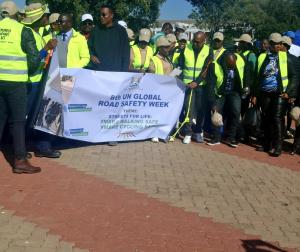Botswana joins the rest of the world in launching the 8th UN Global Road Safety Week
This week, Botswana joins the rest of the world in launching the 8th UN Global Road Safety Week under the theme “Streets for Life: #MakingWalkingAndCyclingSafe.”
Speaking yesterday at the launch, WHO Representative Dr. Fabian Ndenzako emphasized that safe and inclusive roads not only encourage walking and cycling but also enhance physical, mental, and social wellbeing. He noted that road crashes claim an estimated 1.2 million lives and injure 50 million people globally each year, particularly among young people aged 5 to 29. Dr. Ndenzako highlighted the urgent need for safer roads and commended Botswana’s commitment to road safety, while also stressing that there is always room for improvement.
He called for inclusive and multi-sectoral road safety policies, safer infrastructure for all road users, greater community engagement, public education, and stronger enforcement of traffic laws. Dr. Ndenzako reaffirmed the continued support of the UN and WHO in helping countries meet the global target of reducing road traffic deaths and injuries by 50 percent by the year 2030. For his part, assistant Minister of Transport and Infrastructure, Hon. Keoagile Atamelang, emphasized the importance of the global theme, urging stakeholders to prioritize walking and cycling as safe, sustainable, and healthy modes of transport.
He stressed, however, that achieving this requires deliberate and coordinated action, including safer infrastructure, improved road design, and effective speed management, particularly around schools, parks, and residential areas. The Assistant Minister reaffirmed the Government of Botswana’s commitment to improving road safety through a comprehensive, multi-sectoral approach.
This includes regularly reviewing and enforcing traffic laws, raising public awareness through education and outreach campaigns, and investing in safer infrastructure such as proper road lighting, clear signage, and well-maintained pedestrian walkways.
He added that special attention is being given to protecting vulnerable road users, especially pedestrians and cyclists, by creating dedicated lanes and safe crossing points in high-risk areas like schools and residential neighborhoods.
